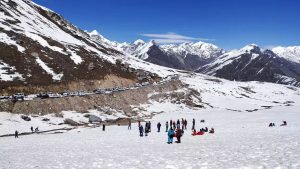Last Updated: June 18, 2019 Kamlesh Nayal
With a history dating back to almost 5000 years or more, India is known for its rich past and cultural heritage. Several dynasties ruled India during different time periods. From Chalukyas, Cholas, and Mauryas to Mughals and British; each dynasty left its mark on the Indian soil in the form of various architectural marvels that have today, become the cynosure of world’s eyes. From historical monuments in Delhi and magnificent forts in Rajasthan to rock carvings in Mahabalipuram and Dravidian temples in South, the list of Indian architectural masterpieces is endless. Your visit to India is incomplete without witnessing the richness of some of its architectural sites listed below.
Delhi
Humayun’s Tomb
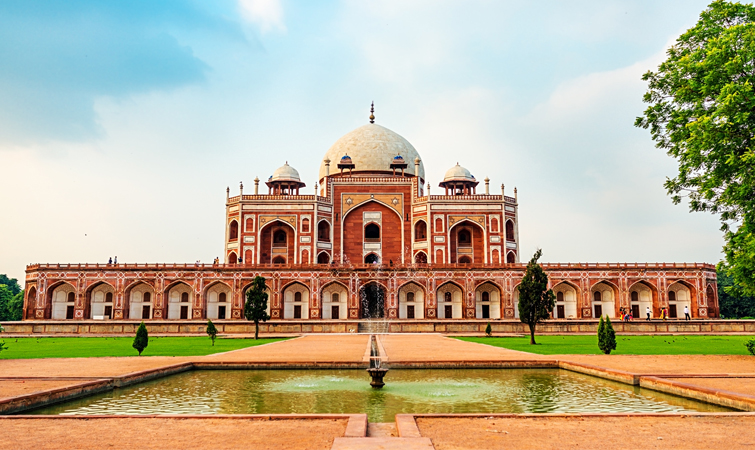 It was the first of its kind garden-tomb in India that reflects the Mughal style of architecture. The tomb was built in the memory of Humayun in 1569, by his widow, Banu Begum. Reflecting a true Mughal architecture with its garden squares, water channels by the side of pathways and a double-domed mausoleum located in the centre of the charbagh, it is also known as the ‘Mini Taj’. Not many people know that Taj Mahal was built after Humayun’s Tomb and it is the design of the Humayun’s Tomb that actually inspired the layout and architecture of the iconic ‘Taj’. Read more here.
It was the first of its kind garden-tomb in India that reflects the Mughal style of architecture. The tomb was built in the memory of Humayun in 1569, by his widow, Banu Begum. Reflecting a true Mughal architecture with its garden squares, water channels by the side of pathways and a double-domed mausoleum located in the centre of the charbagh, it is also known as the ‘Mini Taj’. Not many people know that Taj Mahal was built after Humayun’s Tomb and it is the design of the Humayun’s Tomb that actually inspired the layout and architecture of the iconic ‘Taj’. Read more here.
Akshardham Temple
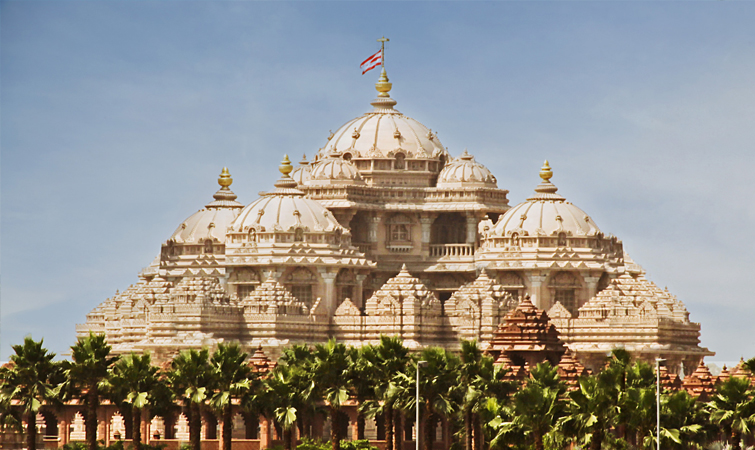 Acclaimed as the world’s second largest Hindu temple after the Akshardham Temple in Gandhinagar, Akshardham Temple in Delhi is a recent addition to the architectural gems of India. The temple was inaugurated on 6th November 2005 and it took 5 years and efforts of 11000 artisans for its massive construction to be completed. Akshardham Temple in Delhi is a part of the Bochasanwasi Shri Akshar Purushottam Swaminarayan Sanstha or BAPS. Made of pink stone and white marble, structure of Akshardham Temple consists of intricately carved pillars and domes decorated with stone statues and figurines depicting scenes from Indian mythology. The spectacular beauty and grandeur of Akshardham Temple is sure to leave you mesmerized.
Acclaimed as the world’s second largest Hindu temple after the Akshardham Temple in Gandhinagar, Akshardham Temple in Delhi is a recent addition to the architectural gems of India. The temple was inaugurated on 6th November 2005 and it took 5 years and efforts of 11000 artisans for its massive construction to be completed. Akshardham Temple in Delhi is a part of the Bochasanwasi Shri Akshar Purushottam Swaminarayan Sanstha or BAPS. Made of pink stone and white marble, structure of Akshardham Temple consists of intricately carved pillars and domes decorated with stone statues and figurines depicting scenes from Indian mythology. The spectacular beauty and grandeur of Akshardham Temple is sure to leave you mesmerized.
Lotus Temple
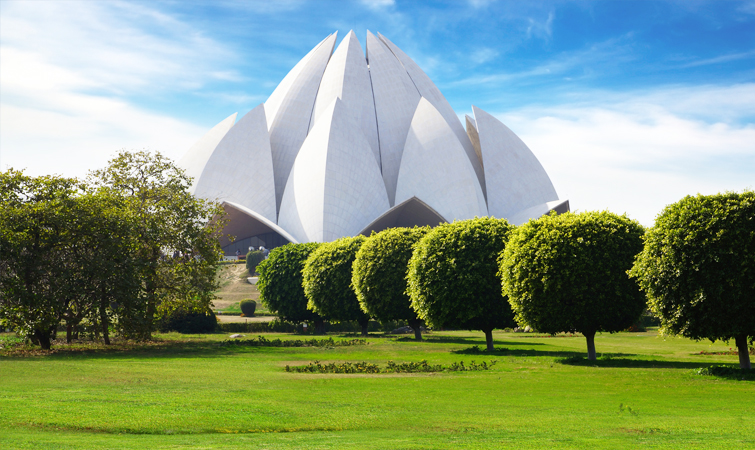 Lotus Temple, also known as the Bahai Temple was constructed in 1986 to bring together different religious faiths on the same platform. The temple’s architecture reflects the shape of a half open Lotus flower. The structure is made of pure white marble and consists of 3 sets of 9 Lotus petals. Enclosed within these petals, is the meditation hall where followers of any faith can go and pray. Around the petals, you will notice 9 pools of water that look spectacular during night when colourful lights fall on the waters. The architecture and design of the Lotus Temple is worth appreciating the architectural skills of the Iranian-Canadian architect, Fariburz Sahba, who commemorated its design.
Lotus Temple, also known as the Bahai Temple was constructed in 1986 to bring together different religious faiths on the same platform. The temple’s architecture reflects the shape of a half open Lotus flower. The structure is made of pure white marble and consists of 3 sets of 9 Lotus petals. Enclosed within these petals, is the meditation hall where followers of any faith can go and pray. Around the petals, you will notice 9 pools of water that look spectacular during night when colourful lights fall on the waters. The architecture and design of the Lotus Temple is worth appreciating the architectural skills of the Iranian-Canadian architect, Fariburz Sahba, who commemorated its design.
Agra, Uttar Pradesh
Taj Mahal
 The ‘Taj Mahal’ needs no introduction. One of the Seven Wonders of the World and a world heritage site, Taj Mahal is an epitome of love that was constructed by the famous Mughal emperor, Shah Jahan in memory of his loving wife, Mumtaz Mahal during 1630 AD. Built from pure white marble in an Indo-Islamic and Persian styles of architecture, Taj also reflects the sheer artistic brilliance of Mughals. A jewel in the crown of Mughal Architecture, the Taj is a must-visit monument for every travel enthusiast, history buff and an art-lover in India. Read more here.
The ‘Taj Mahal’ needs no introduction. One of the Seven Wonders of the World and a world heritage site, Taj Mahal is an epitome of love that was constructed by the famous Mughal emperor, Shah Jahan in memory of his loving wife, Mumtaz Mahal during 1630 AD. Built from pure white marble in an Indo-Islamic and Persian styles of architecture, Taj also reflects the sheer artistic brilliance of Mughals. A jewel in the crown of Mughal Architecture, the Taj is a must-visit monument for every travel enthusiast, history buff and an art-lover in India. Read more here.
Fatehpur Sikri
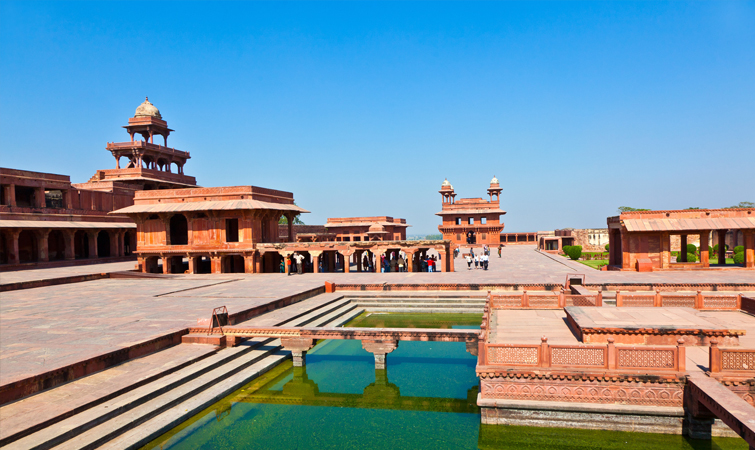 Fatehpur Sikri is known to be the first planned city, built during 16th century by the orders of the famous Mughal Emperor, Akbar. Monuments in Fatehpur Sikri are a blend of Hindu, Persian and Mughal style of architecture. ‘Buland Darwaza’ and ‘Panch Mahal’ are few of the major accomplishments of Mughal architecture and should not be missed during your visit to India. Besides the Buland Darwaza and Panch Mahal, ‘Jami Masjid’ and ‘Tomb of Salim Chsiti’ hold a religious importance and are visited by many tourists every day. Read more here.
Fatehpur Sikri is known to be the first planned city, built during 16th century by the orders of the famous Mughal Emperor, Akbar. Monuments in Fatehpur Sikri are a blend of Hindu, Persian and Mughal style of architecture. ‘Buland Darwaza’ and ‘Panch Mahal’ are few of the major accomplishments of Mughal architecture and should not be missed during your visit to India. Besides the Buland Darwaza and Panch Mahal, ‘Jami Masjid’ and ‘Tomb of Salim Chsiti’ hold a religious importance and are visited by many tourists every day. Read more here.
Rajasthan
Forts
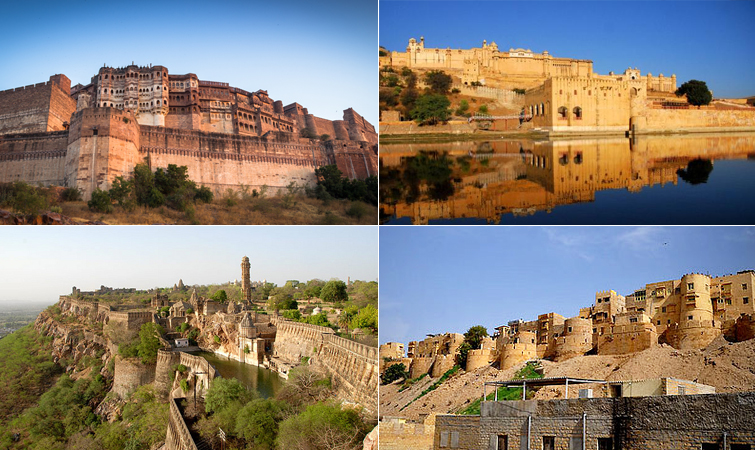 Eclectic architecture of Rajasthan forts boast about the Rajput power and opulence. Magnificent structures of forts, their exquisite décor, succulent gardens with array of fountains and intricate designing display the Rajput patronage towards art. Forts worth visiting in Rajasthan include the ‘Mehrangarh Fort’, ‘Amber Fort’, ‘Chittorgarh Fort’, and ‘Jaisalmer Fort’. Read more here.
Eclectic architecture of Rajasthan forts boast about the Rajput power and opulence. Magnificent structures of forts, their exquisite décor, succulent gardens with array of fountains and intricate designing display the Rajput patronage towards art. Forts worth visiting in Rajasthan include the ‘Mehrangarh Fort’, ‘Amber Fort’, ‘Chittorgarh Fort’, and ‘Jaisalmer Fort’. Read more here.
Ancient Havelis
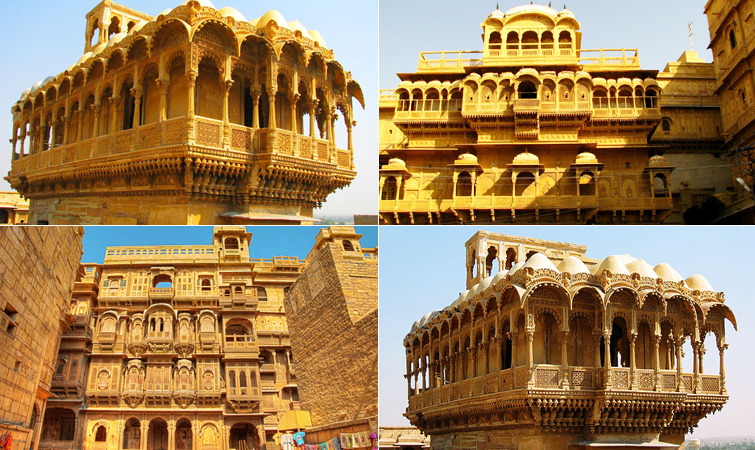 Havelis of Rajasthan, built in Rajput and Islamic styles of architecture, are known for their distinct designs and exquisitely carved sandstone facades, latticed balconies and interior walls adorned with mural paintings. ‘Patwon ki Haveli’, ‘Nathmal ki Haveli’ and ‘Salim ki Haveli’ are worth visiting in Jaisalmer. Shekhawati is another region in Rajasthan that is worth including in your itinerary; ancient havelis of this place are a treat to eyes. If you are in Rajasthan, then a heritage tour of these havelis is a must.
Havelis of Rajasthan, built in Rajput and Islamic styles of architecture, are known for their distinct designs and exquisitely carved sandstone facades, latticed balconies and interior walls adorned with mural paintings. ‘Patwon ki Haveli’, ‘Nathmal ki Haveli’ and ‘Salim ki Haveli’ are worth visiting in Jaisalmer. Shekhawati is another region in Rajasthan that is worth including in your itinerary; ancient havelis of this place are a treat to eyes. If you are in Rajasthan, then a heritage tour of these havelis is a must.
Madhya Pradesh
Khajuraho Temples
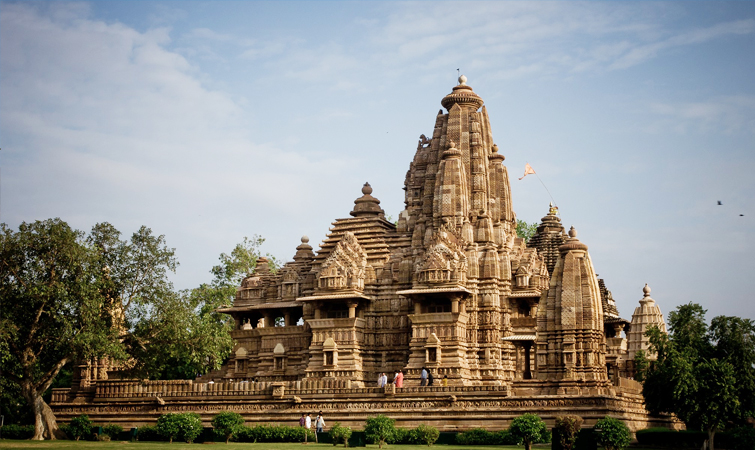 The Khajuraho group of temples are considered to be amongst the greatest masterpieces of Indian art that were built during the Chandella Dynasty between 900 AD and 1130 AD. The architectural brilliance of these temples is just jaw dropping. Carvings of erotic figures, especially the ones depicting love making scenes and voluptuous women, on the temple walls have grabbed the attention of many. Read more here.
The Khajuraho group of temples are considered to be amongst the greatest masterpieces of Indian art that were built during the Chandella Dynasty between 900 AD and 1130 AD. The architectural brilliance of these temples is just jaw dropping. Carvings of erotic figures, especially the ones depicting love making scenes and voluptuous women, on the temple walls have grabbed the attention of many. Read more here.
Sanchi
 Sanchi is a small town famous for its oldest Buddhist monuments dating back to the Mauryan era between 3rd century BC and 12th century AD. Most significant of these monuments is the ‘Sanchi Stupa’ that was carved out of a semi-circular rock. The eye-catching design and architecture of the stupa displays an austere grandeur of its times. The 4 gateways to the stupa are adorned with exquisite carvings depicting the life of Lord Buddha.
Sanchi is a small town famous for its oldest Buddhist monuments dating back to the Mauryan era between 3rd century BC and 12th century AD. Most significant of these monuments is the ‘Sanchi Stupa’ that was carved out of a semi-circular rock. The eye-catching design and architecture of the stupa displays an austere grandeur of its times. The 4 gateways to the stupa are adorned with exquisite carvings depicting the life of Lord Buddha.
Maharashtra
Ajanta and Ellora Caves
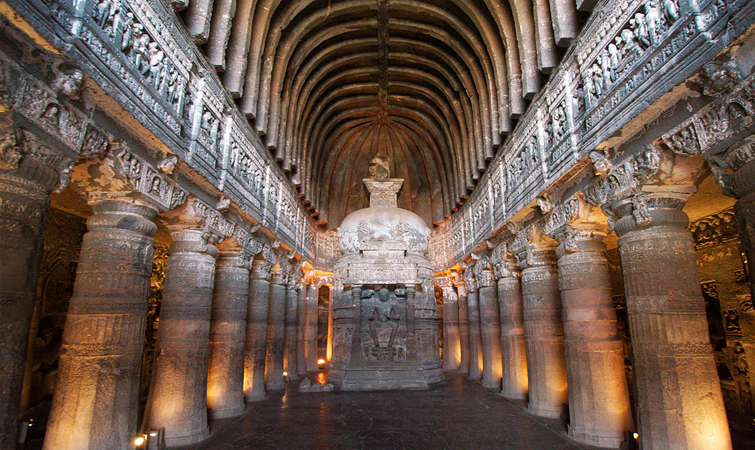 One of the most visited tourist attractions in India, these caves boast of the glorious architectural splendours of the Buddhist monks in ancient India. Dating back to the Gupta period, the sculptures and paintings on the walls of the Ajanta & Ellora Caves depict incidents from the life of Lord Buddha, most interesting of which are the Jataka tales. The paintings in these caves are considered to be an epitome of artistic creativity and a tribute to the craftsmanship of the sculptors of the bygone era.
One of the most visited tourist attractions in India, these caves boast of the glorious architectural splendours of the Buddhist monks in ancient India. Dating back to the Gupta period, the sculptures and paintings on the walls of the Ajanta & Ellora Caves depict incidents from the life of Lord Buddha, most interesting of which are the Jataka tales. The paintings in these caves are considered to be an epitome of artistic creativity and a tribute to the craftsmanship of the sculptors of the bygone era.
Gujarat
Rani Ki Vav
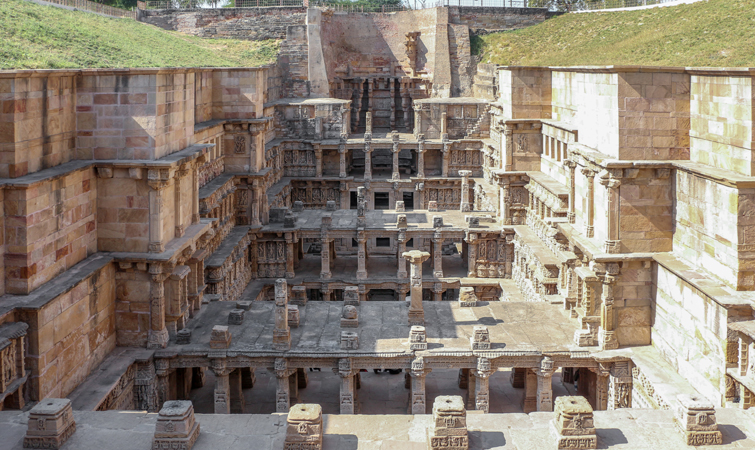 Another excellent example of architectural excellence in India, ‘Rani ki Vav’ is a stepwell located on the banks of the Saraswati River in Patan, Gujarat. The design of well is an amalgamation of architectural and technological brilliance illustrating a true mastery of the craftsmanship. With its figurative motifs and sculptures depicting gods, humans and scenes from mythology, this architectural masterpiece is not worth missing.
Another excellent example of architectural excellence in India, ‘Rani ki Vav’ is a stepwell located on the banks of the Saraswati River in Patan, Gujarat. The design of well is an amalgamation of architectural and technological brilliance illustrating a true mastery of the craftsmanship. With its figurative motifs and sculptures depicting gods, humans and scenes from mythology, this architectural masterpiece is not worth missing.
Odisha
Sun Temple, Konark
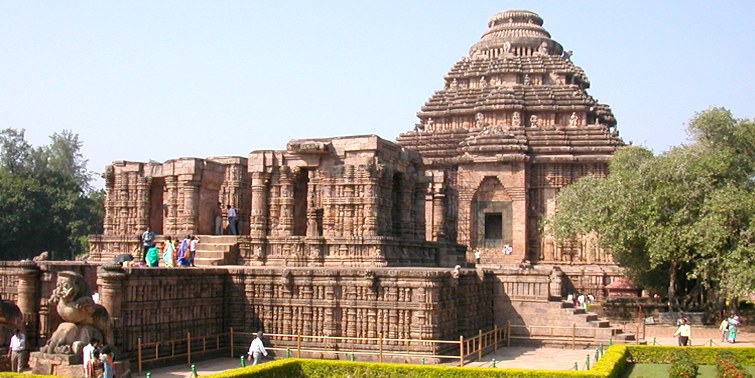 Apart from pilgrims, the ‘Konark Temple’ is visited by many historians and architecture students across the globe. The temple is an outstanding example of temple architecture and art work dating back to the 13th century. Built in the form of chariot of the Sun God, with twelve pairs of exquisitely stone-carved wheels drawn by seven horses, the Sun temple is a masterpiece of art. Read more here.
Apart from pilgrims, the ‘Konark Temple’ is visited by many historians and architecture students across the globe. The temple is an outstanding example of temple architecture and art work dating back to the 13th century. Built in the form of chariot of the Sun God, with twelve pairs of exquisitely stone-carved wheels drawn by seven horses, the Sun temple is a masterpiece of art. Read more here.
Tamil Nadu
Meenakshi Temple
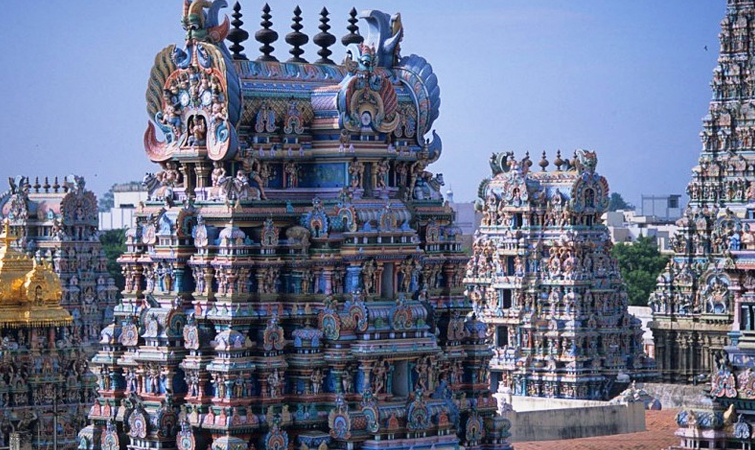 The temple, located in the holy city of Madurai, is a masterpiece of the Dravidian architecture built during 6th century BC by the Pandya rulers. According to the legends, the temple is believed to have been destroyed by Muslim raiders in 14th century and was restored again by the Nayak rulers in 16th century. Richly sculptured and decorated towers known as ‘gopurams’ of today’s Meenakshi Temple, can be seen from a far off distance. Dedicated to Lord Shiva and Goddess Parvati, this temple is an architectural wonder and will surely leave you spellbound.
The temple, located in the holy city of Madurai, is a masterpiece of the Dravidian architecture built during 6th century BC by the Pandya rulers. According to the legends, the temple is believed to have been destroyed by Muslim raiders in 14th century and was restored again by the Nayak rulers in 16th century. Richly sculptured and decorated towers known as ‘gopurams’ of today’s Meenakshi Temple, can be seen from a far off distance. Dedicated to Lord Shiva and Goddess Parvati, this temple is an architectural wonder and will surely leave you spellbound.
Intricately carved sculptures and figurines from Indian mythology can be seen in various halls of the temple. Some of the sculptures worth noticing include the scene of ocean of milk being churned by devas and asuras, nine heads Ravana playing veena, Markandya hugging Shivlingam and scenes from the wedding ceremony of Sundareswarar & Meenakshi.
Another worth admiring feature of the temple is its thousand pillared hall which in itself is an engineering marvel. Each pillar of this hall is built with a single granite rock and produces different musical notes when tapped.
Mahabalipuram
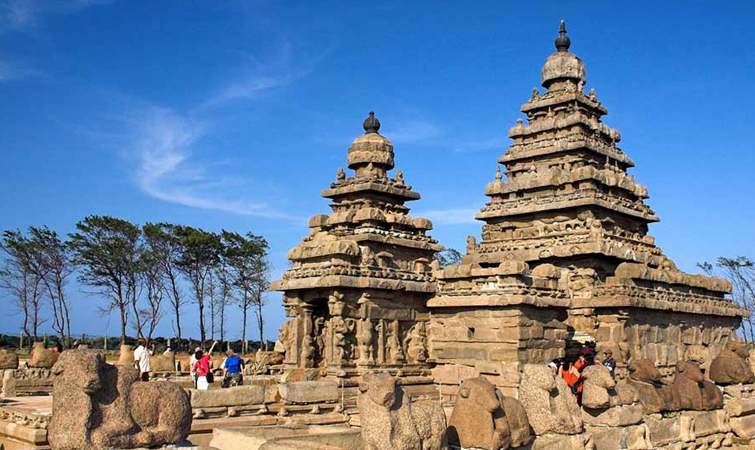 A world heritage site, the place is famous for its monolithic rock-cut monuments and temples dating back to 7th century. The five monolithic rock-cut ‘Rathas’, each dedicated to a Pandava brother from the Mahabharata, are worth noting their architectural elegance. Each ratha is carved in a different shape and size. Magnificently carved walls and façade with sculptures of animals, humans and gods on the rathas, give you an insight into the architectural skills of the sculptors during the Pallava rule.
A world heritage site, the place is famous for its monolithic rock-cut monuments and temples dating back to 7th century. The five monolithic rock-cut ‘Rathas’, each dedicated to a Pandava brother from the Mahabharata, are worth noting their architectural elegance. Each ratha is carved in a different shape and size. Magnificently carved walls and façade with sculptures of animals, humans and gods on the rathas, give you an insight into the architectural skills of the sculptors during the Pallava rule.
Other worth visiting attractions in Mahabalipuram include the ‘Shore Temple’, ‘Arjuna’s Penance’ and rock-cut cave temples in the nearby areas.
Karnataka
Ruins of Hampi
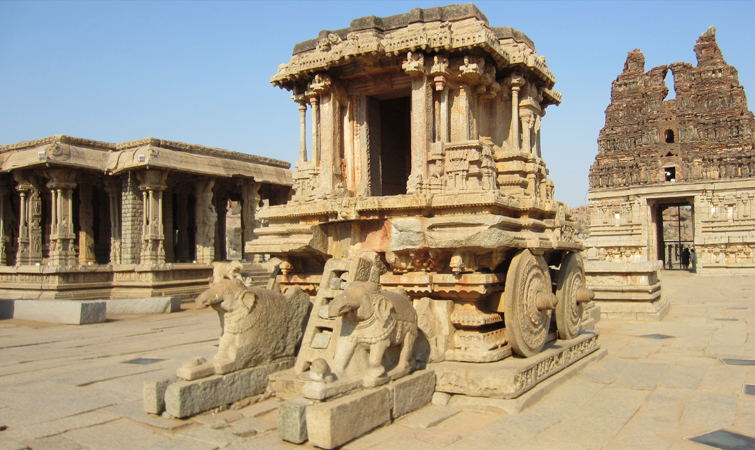 Another world heritage site known for its ancient ruins and temples. The temples are built in Dravidian style of architecture. Delicate carvings on the temple walls and pillars, narrating the stories of Ramayana and Mahabharata, give an insight into the architectural splendour of the artisans of the Vijayanagara Empire during the reign of Raja Krishnadeva Raya between 1509 AD and 1529 AD. Apart from Hindu mythology, carvings of people, animals and demigods can also be seen on the walls and pillars. ‘Shri Vijayavitthala Temple’, dedicated to Lord Vishnu is the major attraction in Hampi and is known for its Stone Chariot, which is a testimony to the excellent design skills of the then Vijaynagara sculptors.
Another world heritage site known for its ancient ruins and temples. The temples are built in Dravidian style of architecture. Delicate carvings on the temple walls and pillars, narrating the stories of Ramayana and Mahabharata, give an insight into the architectural splendour of the artisans of the Vijayanagara Empire during the reign of Raja Krishnadeva Raya between 1509 AD and 1529 AD. Apart from Hindu mythology, carvings of people, animals and demigods can also be seen on the walls and pillars. ‘Shri Vijayavitthala Temple’, dedicated to Lord Vishnu is the major attraction in Hampi and is known for its Stone Chariot, which is a testimony to the excellent design skills of the then Vijaynagara sculptors.
The sites listed above are just a small glimpse at the architectural wonders of India. There are many more sites that can leave you spell bound. If you feel some information is missing or if you have any valuable suggestions, please feel free to comment in the space below.
Photo Courtesy: Fotolia – Royalty-Free Licensed (Purchased Photos)
Published: 02 Jan, 2016
Kamlesh Nayal is the Senior Tour Manager at TourMyIndia.com. With his great managerial skills he takes care of the domestic clientele of the organization. Along with the administrative expertise, he is blessed with a tremendous writing style. Packed with precise factual information, his write ups are very helpful for both Indian and foreign tourists.



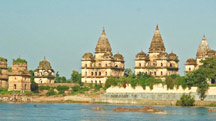 15 Nights / 16 Days
15 Nights / 16 Days 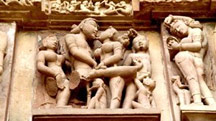 17 Nights / 18 Days
17 Nights / 18 Days 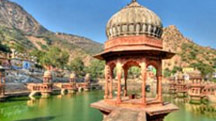 18 Nights / 17 Days
18 Nights / 17 Days 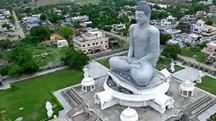 23 Nights / 24 Days
23 Nights / 24 Days  It was the first of its kind garden-tomb in India that reflects the Mughal style of architecture. The tomb was built in the memory of Humayun in 1569, by his widow, Banu Begum. Reflecting a true Mughal architecture with its garden squares, water channels by the side of pathways and a double-domed mausoleum located in the centre of the charbagh, it is also known as the ‘Mini Taj’. Not many people know that Taj Mahal was built after Humayun’s Tomb and it is the design of the Humayun’s Tomb that actually inspired the layout and architecture of the iconic ‘Taj’.
It was the first of its kind garden-tomb in India that reflects the Mughal style of architecture. The tomb was built in the memory of Humayun in 1569, by his widow, Banu Begum. Reflecting a true Mughal architecture with its garden squares, water channels by the side of pathways and a double-domed mausoleum located in the centre of the charbagh, it is also known as the ‘Mini Taj’. Not many people know that Taj Mahal was built after Humayun’s Tomb and it is the design of the Humayun’s Tomb that actually inspired the layout and architecture of the iconic ‘Taj’.  Acclaimed as the world’s second largest Hindu temple after the Akshardham Temple in Gandhinagar, Akshardham Temple in Delhi is a recent addition to the architectural gems of India. The temple was inaugurated on 6th November 2005 and it took 5 years and efforts of 11000 artisans for its massive construction to be completed. Akshardham Temple in Delhi is a part of the Bochasanwasi Shri Akshar Purushottam Swaminarayan Sanstha or BAPS. Made of pink stone and white marble, structure of Akshardham Temple consists of intricately carved pillars and domes decorated with stone statues and figurines depicting scenes from Indian mythology. The spectacular beauty and grandeur of Akshardham Temple is sure to leave you mesmerized.
Acclaimed as the world’s second largest Hindu temple after the Akshardham Temple in Gandhinagar, Akshardham Temple in Delhi is a recent addition to the architectural gems of India. The temple was inaugurated on 6th November 2005 and it took 5 years and efforts of 11000 artisans for its massive construction to be completed. Akshardham Temple in Delhi is a part of the Bochasanwasi Shri Akshar Purushottam Swaminarayan Sanstha or BAPS. Made of pink stone and white marble, structure of Akshardham Temple consists of intricately carved pillars and domes decorated with stone statues and figurines depicting scenes from Indian mythology. The spectacular beauty and grandeur of Akshardham Temple is sure to leave you mesmerized. Lotus Temple, also known as the Bahai Temple was constructed in 1986 to bring together different religious faiths on the same platform. The temple’s architecture reflects the shape of a half open Lotus flower. The structure is made of pure white marble and consists of 3 sets of 9 Lotus petals. Enclosed within these petals, is the meditation hall where followers of any faith can go and pray. Around the petals, you will notice 9 pools of water that look spectacular during night when colourful lights fall on the waters. The architecture and design of the Lotus Temple is worth appreciating the architectural skills of the Iranian-Canadian architect, Fariburz Sahba, who commemorated its design.
Lotus Temple, also known as the Bahai Temple was constructed in 1986 to bring together different religious faiths on the same platform. The temple’s architecture reflects the shape of a half open Lotus flower. The structure is made of pure white marble and consists of 3 sets of 9 Lotus petals. Enclosed within these petals, is the meditation hall where followers of any faith can go and pray. Around the petals, you will notice 9 pools of water that look spectacular during night when colourful lights fall on the waters. The architecture and design of the Lotus Temple is worth appreciating the architectural skills of the Iranian-Canadian architect, Fariburz Sahba, who commemorated its design. The ‘Taj Mahal’ needs no introduction. One of the Seven Wonders of the World and a world heritage site, Taj Mahal is an epitome of love that was constructed by the famous Mughal emperor, Shah Jahan in memory of his loving wife, Mumtaz Mahal during 1630 AD. Built from pure white marble in an Indo-Islamic and Persian styles of architecture, Taj also reflects the sheer artistic brilliance of Mughals. A jewel in the crown of Mughal Architecture, the Taj is a must-visit monument for every travel enthusiast, history buff and an art-lover in India.
The ‘Taj Mahal’ needs no introduction. One of the Seven Wonders of the World and a world heritage site, Taj Mahal is an epitome of love that was constructed by the famous Mughal emperor, Shah Jahan in memory of his loving wife, Mumtaz Mahal during 1630 AD. Built from pure white marble in an Indo-Islamic and Persian styles of architecture, Taj also reflects the sheer artistic brilliance of Mughals. A jewel in the crown of Mughal Architecture, the Taj is a must-visit monument for every travel enthusiast, history buff and an art-lover in India.  Fatehpur Sikri is known to be the first planned city, built during 16th century by the orders of the famous Mughal Emperor, Akbar. Monuments in Fatehpur Sikri are a blend of Hindu, Persian and Mughal style of architecture. ‘Buland Darwaza’ and ‘Panch Mahal’ are few of the major accomplishments of Mughal architecture and should not be missed during your visit to India. Besides the Buland Darwaza and Panch Mahal, ‘Jami Masjid’ and ‘Tomb of Salim Chsiti’ hold a religious importance and are visited by many tourists every day.
Fatehpur Sikri is known to be the first planned city, built during 16th century by the orders of the famous Mughal Emperor, Akbar. Monuments in Fatehpur Sikri are a blend of Hindu, Persian and Mughal style of architecture. ‘Buland Darwaza’ and ‘Panch Mahal’ are few of the major accomplishments of Mughal architecture and should not be missed during your visit to India. Besides the Buland Darwaza and Panch Mahal, ‘Jami Masjid’ and ‘Tomb of Salim Chsiti’ hold a religious importance and are visited by many tourists every day.  Eclectic architecture of Rajasthan forts boast about the Rajput power and opulence. Magnificent structures of forts, their exquisite décor, succulent gardens with array of fountains and intricate designing display the Rajput patronage towards art. Forts worth visiting in Rajasthan include the ‘Mehrangarh Fort’, ‘Amber Fort’, ‘Chittorgarh Fort’, and ‘Jaisalmer Fort’.
Eclectic architecture of Rajasthan forts boast about the Rajput power and opulence. Magnificent structures of forts, their exquisite décor, succulent gardens with array of fountains and intricate designing display the Rajput patronage towards art. Forts worth visiting in Rajasthan include the ‘Mehrangarh Fort’, ‘Amber Fort’, ‘Chittorgarh Fort’, and ‘Jaisalmer Fort’.  Havelis of Rajasthan, built in Rajput and Islamic styles of architecture, are known for their distinct designs and exquisitely carved sandstone facades, latticed balconies and interior walls adorned with mural paintings. ‘Patwon ki Haveli’, ‘Nathmal ki Haveli’ and ‘Salim ki Haveli’ are worth visiting in Jaisalmer. Shekhawati is another region in Rajasthan that is worth including in your itinerary; ancient havelis of this place are a treat to eyes. If you are in Rajasthan, then a heritage tour of these havelis is a must.
Havelis of Rajasthan, built in Rajput and Islamic styles of architecture, are known for their distinct designs and exquisitely carved sandstone facades, latticed balconies and interior walls adorned with mural paintings. ‘Patwon ki Haveli’, ‘Nathmal ki Haveli’ and ‘Salim ki Haveli’ are worth visiting in Jaisalmer. Shekhawati is another region in Rajasthan that is worth including in your itinerary; ancient havelis of this place are a treat to eyes. If you are in Rajasthan, then a heritage tour of these havelis is a must. The Khajuraho group of temples are considered to be amongst the greatest masterpieces of Indian art that were built during the Chandella Dynasty between 900 AD and 1130 AD. The architectural brilliance of these temples is just jaw dropping. Carvings of erotic figures, especially the ones depicting love making scenes and voluptuous women, on the temple walls have grabbed the attention of many.
The Khajuraho group of temples are considered to be amongst the greatest masterpieces of Indian art that were built during the Chandella Dynasty between 900 AD and 1130 AD. The architectural brilliance of these temples is just jaw dropping. Carvings of erotic figures, especially the ones depicting love making scenes and voluptuous women, on the temple walls have grabbed the attention of many.  Sanchi is a small town famous for its oldest Buddhist monuments dating back to the Mauryan era between 3rd century BC and 12th century AD. Most significant of these monuments is the ‘Sanchi Stupa’ that was carved out of a semi-circular rock. The eye-catching design and architecture of the stupa displays an austere grandeur of its times. The 4 gateways to the stupa are adorned with exquisite carvings depicting the life of Lord Buddha.
Sanchi is a small town famous for its oldest Buddhist monuments dating back to the Mauryan era between 3rd century BC and 12th century AD. Most significant of these monuments is the ‘Sanchi Stupa’ that was carved out of a semi-circular rock. The eye-catching design and architecture of the stupa displays an austere grandeur of its times. The 4 gateways to the stupa are adorned with exquisite carvings depicting the life of Lord Buddha. One of the most visited tourist attractions in India, these caves boast of the glorious architectural splendours of the Buddhist monks in ancient India. Dating back to the Gupta period, the sculptures and paintings on the walls of the Ajanta & Ellora Caves depict incidents from the life of Lord Buddha, most interesting of which are the Jataka tales. The paintings in these caves are considered to be an epitome of artistic creativity and a tribute to the craftsmanship of the sculptors of the bygone era.
One of the most visited tourist attractions in India, these caves boast of the glorious architectural splendours of the Buddhist monks in ancient India. Dating back to the Gupta period, the sculptures and paintings on the walls of the Ajanta & Ellora Caves depict incidents from the life of Lord Buddha, most interesting of which are the Jataka tales. The paintings in these caves are considered to be an epitome of artistic creativity and a tribute to the craftsmanship of the sculptors of the bygone era. Another excellent example of architectural excellence in India, ‘Rani ki Vav’ is a stepwell located on the banks of the Saraswati River in Patan, Gujarat. The design of well is an amalgamation of architectural and technological brilliance illustrating a true mastery of the craftsmanship. With its figurative motifs and sculptures depicting gods, humans and scenes from mythology, this architectural masterpiece is not worth missing.
Another excellent example of architectural excellence in India, ‘Rani ki Vav’ is a stepwell located on the banks of the Saraswati River in Patan, Gujarat. The design of well is an amalgamation of architectural and technological brilliance illustrating a true mastery of the craftsmanship. With its figurative motifs and sculptures depicting gods, humans and scenes from mythology, this architectural masterpiece is not worth missing. Apart from pilgrims, the ‘Konark Temple’ is visited by many historians and architecture students across the globe. The temple is an outstanding example of temple architecture and art work dating back to the 13th century. Built in the form of chariot of the Sun God, with twelve pairs of exquisitely stone-carved wheels drawn by seven horses, the Sun temple is a masterpiece of art.
Apart from pilgrims, the ‘Konark Temple’ is visited by many historians and architecture students across the globe. The temple is an outstanding example of temple architecture and art work dating back to the 13th century. Built in the form of chariot of the Sun God, with twelve pairs of exquisitely stone-carved wheels drawn by seven horses, the Sun temple is a masterpiece of art.  The temple, located in the holy city of Madurai, is a masterpiece of the Dravidian architecture built during 6th century BC by the Pandya rulers. According to the legends, the temple is believed to have been destroyed by Muslim raiders in 14th century and was restored again by the Nayak rulers in 16th century. Richly sculptured and decorated towers known as ‘gopurams’ of today’s Meenakshi Temple, can be seen from a far off distance. Dedicated to Lord Shiva and Goddess Parvati, this temple is an architectural wonder and will surely leave you spellbound.
The temple, located in the holy city of Madurai, is a masterpiece of the Dravidian architecture built during 6th century BC by the Pandya rulers. According to the legends, the temple is believed to have been destroyed by Muslim raiders in 14th century and was restored again by the Nayak rulers in 16th century. Richly sculptured and decorated towers known as ‘gopurams’ of today’s Meenakshi Temple, can be seen from a far off distance. Dedicated to Lord Shiva and Goddess Parvati, this temple is an architectural wonder and will surely leave you spellbound. A world heritage site, the place is famous for its monolithic rock-cut monuments and temples dating back to 7th century. The five monolithic rock-cut ‘Rathas’, each dedicated to a Pandava brother from the Mahabharata, are worth noting their architectural elegance. Each ratha is carved in a different shape and size. Magnificently carved walls and façade with sculptures of animals, humans and gods on the rathas, give you an insight into the architectural skills of the sculptors during the Pallava rule.
A world heritage site, the place is famous for its monolithic rock-cut monuments and temples dating back to 7th century. The five monolithic rock-cut ‘Rathas’, each dedicated to a Pandava brother from the Mahabharata, are worth noting their architectural elegance. Each ratha is carved in a different shape and size. Magnificently carved walls and façade with sculptures of animals, humans and gods on the rathas, give you an insight into the architectural skills of the sculptors during the Pallava rule. Another world heritage site known for its ancient ruins and temples. The temples are built in Dravidian style of architecture. Delicate carvings on the temple walls and pillars, narrating the stories of Ramayana and Mahabharata, give an insight into the architectural splendour of the artisans of the Vijayanagara Empire during the reign of Raja Krishnadeva Raya between 1509 AD and 1529 AD. Apart from Hindu mythology, carvings of people, animals and demigods can also be seen on the walls and pillars. ‘Shri Vijayavitthala Temple’, dedicated to Lord Vishnu is the major attraction in Hampi and is known for its Stone Chariot, which is a testimony to the excellent design skills of the then Vijaynagara sculptors.
Another world heritage site known for its ancient ruins and temples. The temples are built in Dravidian style of architecture. Delicate carvings on the temple walls and pillars, narrating the stories of Ramayana and Mahabharata, give an insight into the architectural splendour of the artisans of the Vijayanagara Empire during the reign of Raja Krishnadeva Raya between 1509 AD and 1529 AD. Apart from Hindu mythology, carvings of people, animals and demigods can also be seen on the walls and pillars. ‘Shri Vijayavitthala Temple’, dedicated to Lord Vishnu is the major attraction in Hampi and is known for its Stone Chariot, which is a testimony to the excellent design skills of the then Vijaynagara sculptors.

